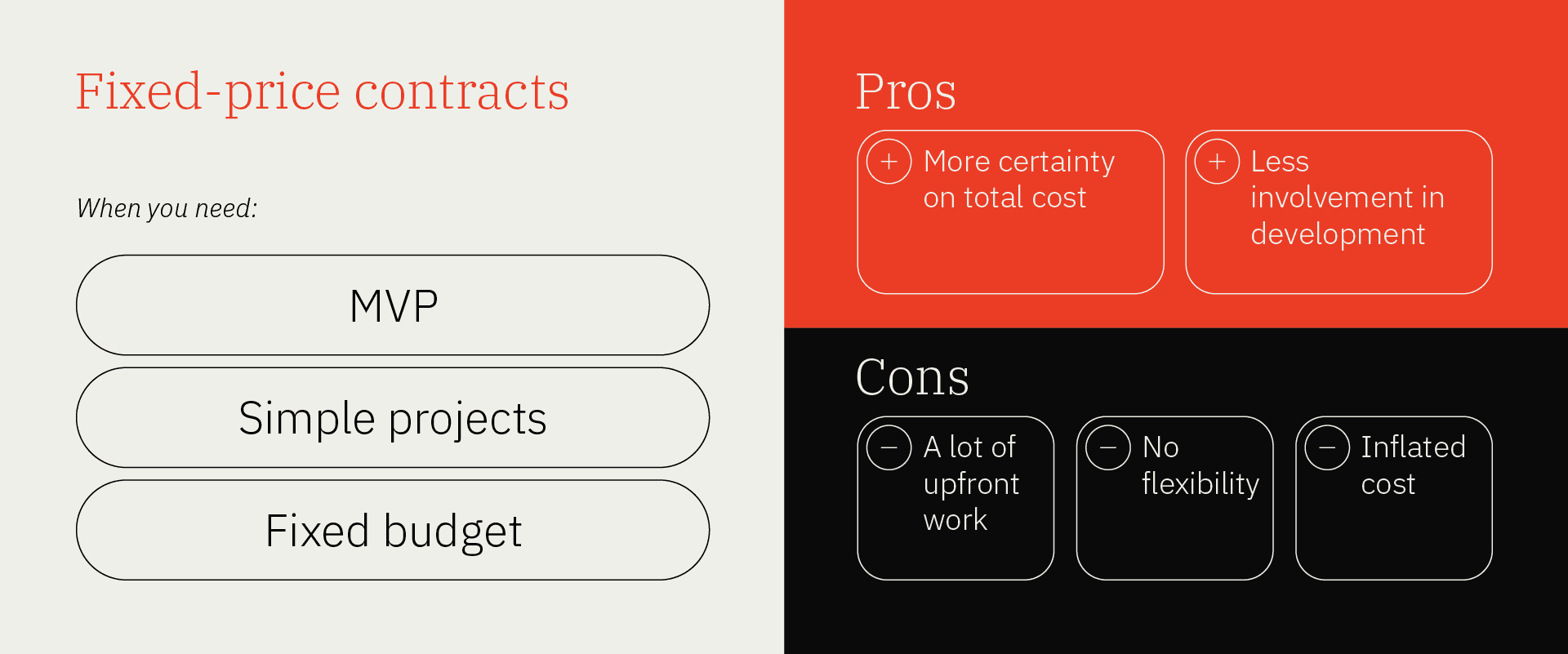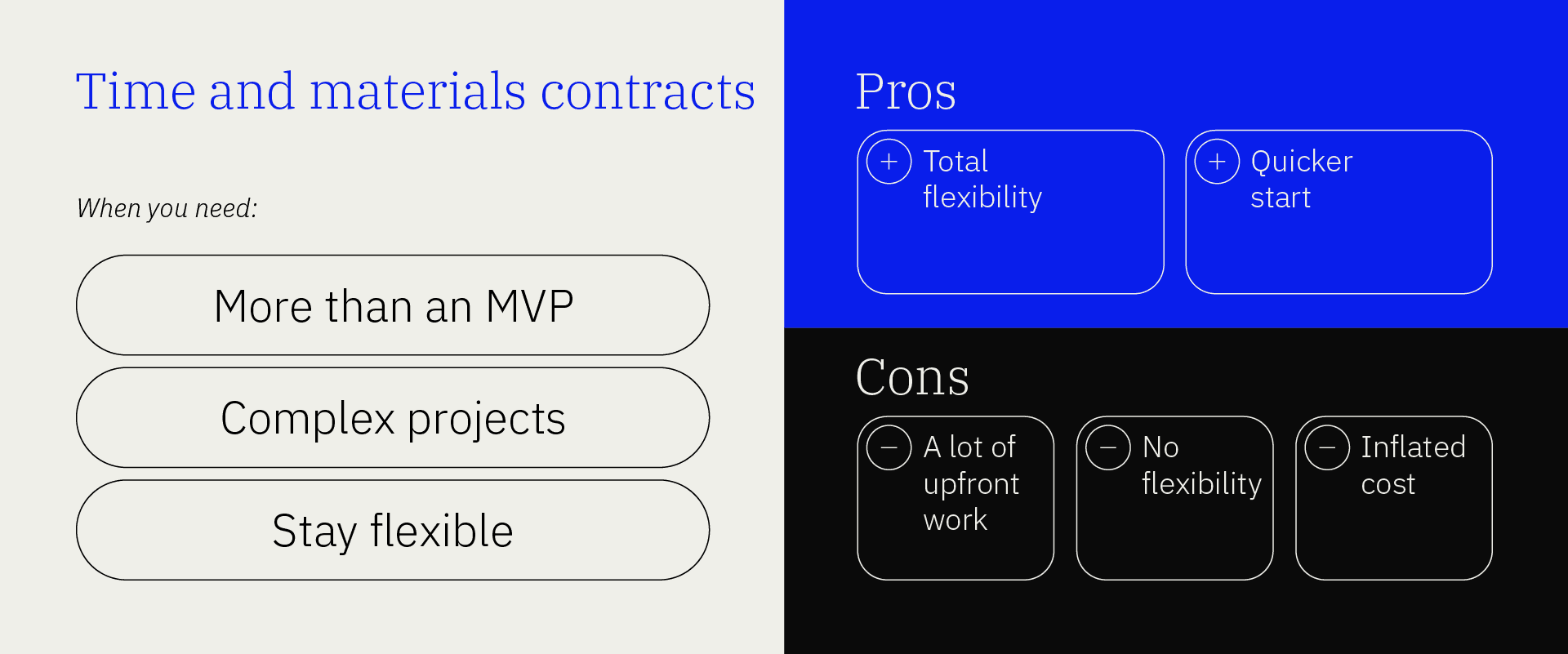
A tale of two billing models: time and materials vs fixed-price

When you need to work with outside vendors on a software development project, one of the biggest considerations is what type of billing model makes the most sense for your specific needs and budget.
Although vendors may have more than one pricing model that they are willing to work under, the two most common that you will likely have to choose from for your project are fixed-price or time and materials.
What is a fixed-price contract?
As its name implies, a fixed-price contract is one where the total cost of the project is agreed upon prior to commencing work. For this model to work, both the vendor and customer must have a solid understanding of the specific scope for the project, and a clear deadline for delivery is established.
What is a time and materials contract?
A time and materials contract is one in which the vendor bills you an hourly rate for all of the hours of labor taken to develop the software, in addition to any material costs incurred to complete your project. This doesn't, however, mean providing a blank check to the vendor, as they will still generally be able to give an estimated cost range as the deliverables are identified, and provide regular status updates so that you can determine priorities as they go.
What are the pros and cons of each pricing model?
For those who are unfamiliar with the process of software development, there may be an instinct to gravitate towards a fixed-price contract – after all, you generally wouldn't make a major purchase if you didn't know what the final cost was going to be. However, due to the nature of software development, the answer is not always straightforward, and there are definite pros and cons of each pricing model to consider.
Fixed-price contracts
- More certainty on total cost and delivery date. Everything is governed by the contract. You know that as long as the project scope doesn't change there shouldn't be any nasty surprises. This means there is less risk to you because if the vendor has underestimated the work required, they bear the financial burden.
- Be prepared for a lot of upfront work. Any vendor willing to deliver for a fixed-fee is going to need to see the project scope and deliverables presented in a way that leaves no room for misinterpretation. This means that you will be doing a lot of work before seeking vendors to identify every feature you need, and how it needs to look. Depending on your project, this may mean creating extensive notes, wireframes, user stories, design mockups, and more.
- No flexibility. Once the project scope of deliverables is agreed upon, that is the project you are getting. If you need any modifications, it will almost certainly mean creating a new contract and additional time and costs.
- Potential for inflated cost. When the risk for the project falls entirely on the vendor, it becomes almost certain that the vendor will need to compensate for this by padding the project cost to avoid losing money.
Time and Material Contracts
- Total flexibility. This type of contract allows you to make changes as necessary. Need to add or remove a feature? Not a problem! You can get estimates for each change which will help provide a degree of accountability for the vendor as the project progresses.
- Quicker start. Unlike a fixed-price contract, you don’t need to have all the details hammered out to begin working.
- A high level of involvement is required. Because of the dynamic nature of working in this way, you will be involved in the day to day management of the project in a much greater capacity than with a fixed-price contract.
- Costs can be greater than expected. The flexibility to make changes while the project is underway comes at a cost. Every new feature or improvement may lead to a finished product that costs a lot more than you anticipated.
When you need a fixed-price contract

A fixed-price contract makes the most sense in cases where:
- The project is relatively simple in nature. You don't need advanced features or multiple rounds of user testing. This model can work well when you just need to get a minimum viable product (MVP) ready within a set time and budget.
- Your budget is fixed. Whether you are an entrepreneur looking to bootstrap your project, or part of an established organization with strict budgeting approval requirements, there is sometimes no escaping the need to stay within a strict budget.
When you need a time and materials contract

A time and materials contract may be the best choice for you when the following is true:
- The project is large and complex. In this scenario, there is no feasible way to realistically predict the amount of time specific features will take to implement.
- You want or need more than an MVP. It generally takes multiple rounds of user testing and iterations to end up with software that feels truly polished. There is no financial incentive for a vendor working on a fixed-price contract to refine the software once the agreed upon scope of deliverables has been met.
- The project may need to change direction midway through development. Whether due to outside factors like a change in market conditions or a competitor launching a similar product, a T&M contract allows you to adapt right away without losing the time it takes to negotiate a new contract.
Conclusion
As has been shown, both pricing models have their place. However, choosing the wrong option for your particular project can undoubtedly create an unsatisfactory outcome for either, or both parties. By carefully weighing the pros and cons of each pricing model and taking the time to find a vendor that you trust, you stand a much better chance of having your project be a success.





